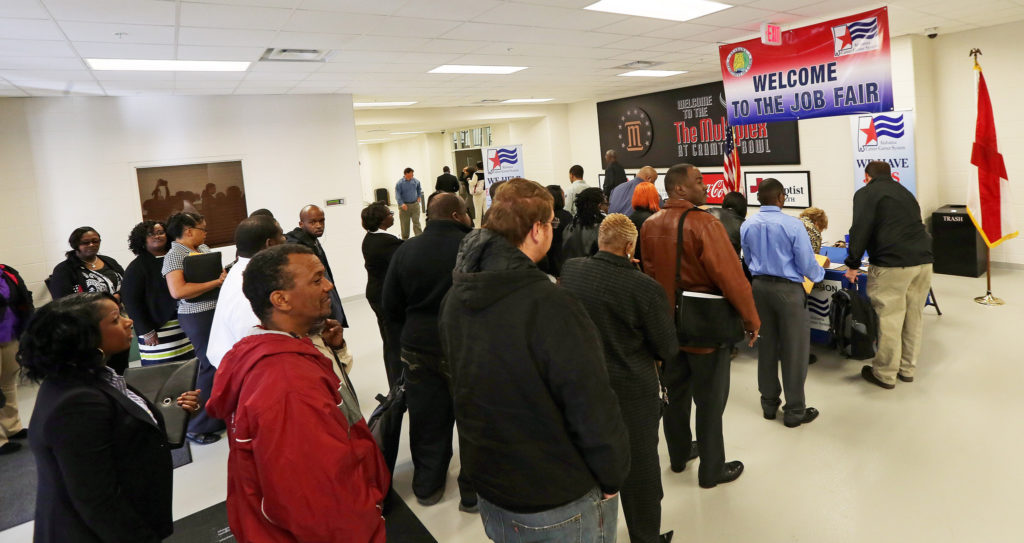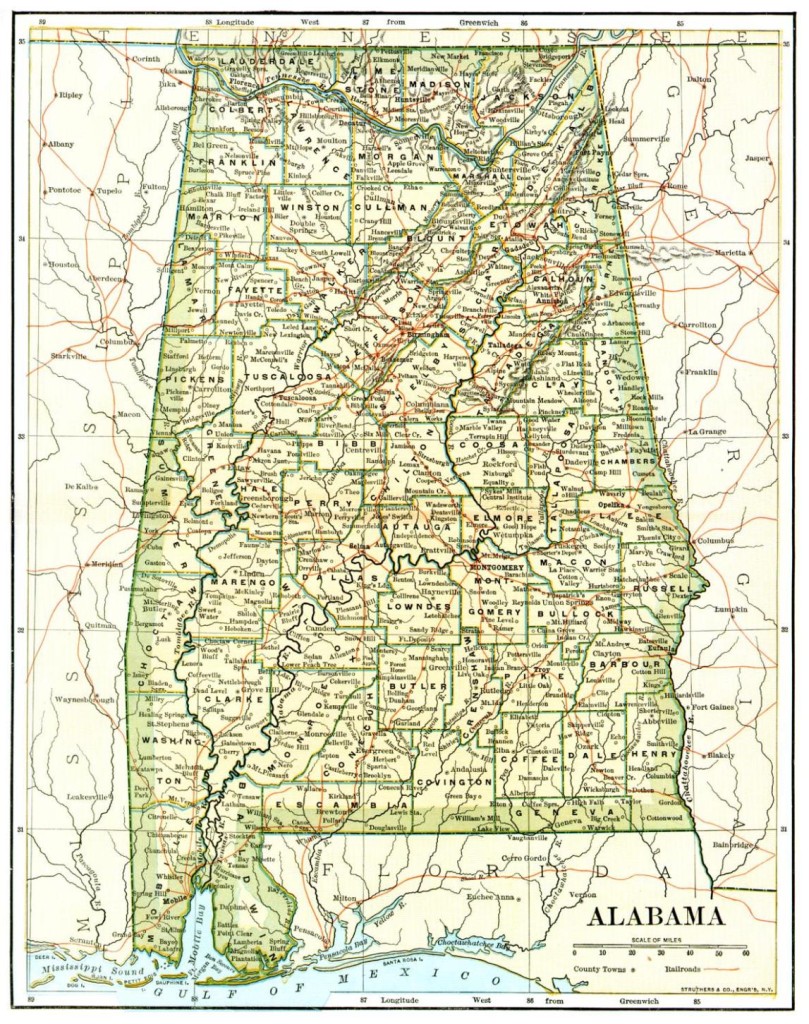Email insights: Robert Bentley announces Alabama regional job fairs are putting Alabamians back to work

Gov. Robert Bentley issued a statement Monday on the success of Regional Jobs Fairs after having recently received a presentation from Alabama Department of Labor (ADOL) Commissioner Fitzgerald Washington on the successful outcome of the fairs that are being hosted by ADOL across the Yellowhammer state. The job fairs initiative began nearly one year ago when ADOL launched an effort to bring down unemployment rates in counties with traditionally high rates. Accordingly to Bentley, as of May 2016, four of the five underserved counties have experienced significant drops in their unemployment rates. Read Bentley’s full statement here: Governor Robert Bentley received a presentation from Alabama Department of Labor Commissioner Fitzgerald Washington on the successful outcome of the Regional Job Fairs that are being hosted by the Department of Labor throughout the state. Approximately one year ago, the Department launched an effort aimed at bringing down unemployment rates in counties with traditionally high rates. By working with local government and education officials, ADOL was able to bring employers to these mostly rural areas and connect job seekers with jobs. Over the course of 2015, five job fairs were held in Dallas, Greene, Lowndes, Perry, and Wilcox counties. “Putting Alabamians back to work is a key part of my Great State 2019 plan,” Governor Robert Bentley said. “Anytime we have an opportunity to connect hundreds of employers with thousands of job seekers, everyone benefits. For an example, in Wilcox County the pre-job fair unemployment rate was 16.5%, now the post-job fair unemployment rate is 13.5%.” As of May 2016, four of the five underserved counties have experienced significant drops in their unemployment rates. In 2016, laid-off coal miners and steel workers dominated the headlines. ADOL took a more targeted approach and conducted two job fairs in the West Alabama area, aimed at helping these workers get back on their feet. More than 1,500 job seekers turned out to meet with over 100 employers. Additionally, a plan was put into place to bring the job fairs to the general public. So far, regional job fairs have been held in Tuscaloosa, Montgomery and Birmingham, with attendance nearing 10,000. Hundreds of unemployed Alabamians have found work through these efforts, and more regional job fairs are scheduled throughout the year. Following the Montgomery job fair in February, Todd Butler landed a management position at Home Depot. “I was out of a job, been looking for a couple of months,” Butler said. “I couldn’t believe the amount of people at the job fair.” Butler was one of 3,300 people who attended the job fair back in February. He spoke to 30 companies that day, with Home Depot being his top choice. He says the new job has brought a new challenge and new focus to his life. “It’s limitless,” Butler said. “Home Depot is the largest home improvement company in the world. So, there’s only upward to go from here.” “With each job fair we host, we are finding more and more interest, both from employers and job seekers,” said Washington. “People are eager to put their best foot forward and find meaningful employment, and employers are constantly looking for great employees. We are pleased to be able to offer these services free of charge and are always looking for new and innovative ways to help Alabamians go back to work.” Four additional job fairs are scheduled for 2016 in the following areas: in August a Maritime Job Fair will be held in Mobile, in September a job fair will be held in the Wiregrass Area, in October the Governor’s Disability Summit will be held in Birmingham, and in November a second job fair will be held in Montgomery. For more information on seeking a job visit Alabama job link.
Alabama unemployment rate drops in April 2016, adds 16,500 jobs

Alabama’s total unemployment rate continued to fall in April, dropping to 6.1 percent from the March rate of 6.2 percent, according to data released Friday by Governor Robert Bentley‘s office. Wage and salary employment increased in April by 16,500 jobs, with increases seen in the fields of: Trade, transportation, and utilities sector — an increase of 3,600 jobs Professional and business services sector — an increase of 3,500 jobs Leisure and hospitality sector — an increase of 2,100 jobs “Every aspect of this month’s jobs data reflects positively on Alabama’s economy,” Governor Bentley said. “More people are working and more jobs are filled. In fact, we are supporting almost 100,000 more jobs now than we were at the height of the recession. We are continuously working to keep that momentum going, with events like last week’s huge job fair in Birmingham that drew more than 5,000 job seekers.” Wage and salary employment measured 1,971,300 in April 2016. In comparison, when the governor took office in January 2011, the wage and salary employment measured 1,839,400 — a 131,900 job improvement. “This is a promising month for us,” Alabama Department of Labor Commissioner Fitzgerald Washington said. “There are more people looking for work and more people working this month than there have been all year. The number of people who are unemployed is down. We continue to see growth in our wage and salary employment, surpassing economists’ growth expectations by nearly 8,000 jobs only four months into the year.” All major Alabama cities, metro areas, and 67 Alabama counties experienced drops in the unemployment rate. Counties with the lowest unemployment rates are: Shelby County at 4.0%, Elmore County at 4.5%, and Cherokee County at 4.6%. Major cities with the lowest unemployment rates are: Vestavia Hills at 3.4%, Homewood at 3.7%, and Hoover at 3.9%.
Robert Bentley submits state’s workforce plan to federal government

On Friday, Gov. Robert Bentley released a statement announcing that the Governor’s Combined State Plan on workforce development and training opportunities has been submitted to the federal government. The plan defines the actions that will be taken to implement the 2015 Workforce Innovation and Opportunity Act (WIOA) and is meant to serve as a guide for improving workforce development. The plan was developed by the Alabama Workforce Development Board and was submitted to the governor earlier this week. “I appreciate the hard work of the Alabama Workforce Development Board to develop a comprehensive plan to guide our state over the next four years,” Bentley said in a press release. “The workforce development plan shows that many state agencies are working together to create opportunities to grow Alabama’s workforce, to make sure job seekers have the skills needed to fill positions desired by employers, and that qualified Alabama citizens are filling those jobs.” Monthly task force meetings between “representatives from the core and partner state agencies” began July 2015. The meetings were designed to “share agency resources, identify needs for new or improved services and programs, and to identify areas where duplicated or competing services can be eliminated.” Action items in the plan were based on initiatives created by the Accelerate Alabama Strategic Economic Development Plan and those recommended by the Alabama Workforce Council. Bentley notes in the press release that the plan is “a product of collaboration, alignment of programs and efficient use of resources through the various partner programs.” “The Alabama Workforce Development Board, which was appointed by Governor Robert Bentley, brings the state of Alabama closer to full alignment between business, industry, and education and bringing those sectors together with job seekers,” George Clark, chair of the AWD Board, said in the statement. “Alabama’s Workforce Investment Board is composed of representatives of the Alabama Workforce Council, the Regional Workforce Development Councils and key industry sectors, as outlined in the Accelerate Alabama plan. On behalf of the AWD Board of Directors, I would like to thank Governor Bentley for his continued leadership in workforce development and economic development in the state of Alabama.” “The WIOA is a sweeping piece of legislation that will impact a significant portion of our population,” Fitzgerald Washington, Commissioner of the Alabama Department of Labor said. “The Alabama Career Center System is at the front line in providing the valuable services covered under the Act. These services will allow people to get additional vocational or educational training, earn degrees, and ultimately reach their goal of finding gainful employment. We are proud to present this plan which gives us the ability to work with all of these wonderful partners to help Alabamians’ dreams come true.” The WIOA is designed to ensure that eligible citizens have the assistance necessary to become work ready through Adult Workforce programs, Dislocated Worker Programs, Youth Training Programs, Adult Education and Vocational Rehabilitation services. These programs are managed by the state through various departments and funded by Commerce WIOA funds.
State’s February unemployment rate holds fast at 6.2 percent

Gov. Robert Bentley said Friday that Alabama’s seasonally adjusted unemployment rate had held steady at 6.2 percent, though the unadjusted rate is 6.5 percent. “The momentum that we are seeing in our employment numbers continues to be encouraging,” Bentley said in a news release. “Our mission to provide all Alabamians with a job remains my top priority. The growth that we are consistently seeing, combined with the regular announcements of new jobs coming to the state, is helping us to achieve that goal. Our economy is supporting 106,900 more jobs now than when I took office in January 2011. But there’s still a lot of work to do, and I remain committed to doing that work.” “No change in the unemployment rate is good news this month,” Alabama Department of Labor Commissioner Fitzgerald Washington said in the press release. “We continue to see high numbers of employed people, which again is topping 2 million. We have consistently seen over 2 million employed people for 21 straight months. Additionally, a high number of people are in the workforce, which tells us that people are confident in the labor market. People haven’t shown this level of confidence in the job market in over three years.” The release notes that, according to the Current Population Survey (CPS), the number of people employed in February was 2,033,386, the highest number since August 2008. In all, 2,167,723 Alabamians are employed, the highest number since October 2012. Wage and salary employment came in at just over 1.9 million, the highest number since February 2008, an increase of more than 24,000. Significant increases were shown in the education and health services sector (+5,900), the trade, transportation, and utilities sector (+5,400), and the professional and business services sector (+5,000), among others. The state’s lowest unemployment rates were seen in Shelby County (4.7 percent), Elmore County (5.4 percent), and Lee County (5.5 percent). Despite an unchanging unemployment rate and significant gains in certain sectors, several Alabama counties are still experiencing unemployment rates at or above 10 percent: Clarke County (12.5 percent), Greene County (10.8 percent), Lowndes County (11.4 percent), Monroe County (10.7 percent), Perry County (10.1 percent), and Wilcox County (15.4 percent). In all, 52 of Alabama’s 67 counties are at or above the state’s current unemployment rate, with 22 above 7.5 percent.
Alabama unemployment ticks up in January

On Monday, Gov. Robert Bentley announced that Alabama’s January unemployment rate came in at 6.2 percent, a slight increase over the 6 percent in December. The Civilian Labor Force (CLF) increased by more than 8,000, bringing the state’s CLF total to 2,154,061. Similarly, the number of employed Alabamians increased by about the same margins, bringing the total of people employed to its highest number since October 2008. Wage and salary employment came in at 1,930,300, the highest number since January 2008. Overall, such employment has increased by more than 18,000, with significant increases seen in the education and health services sector (more than 5,700); the trade, transportation and utilities sector (more than 5,400); and the professional and business services sector (more than 4,600). The counties with the lowest unemployment rates include Shelby at 4.5 percent, Elmore and Lee at 5.3 percent, and Autauga and St. Clair at 5.4 percent. However, a number of Alabama counties are still seeing unemployment rates over 10 percent, including Clarke (12.4 percent), Greene (10.8 percent), Lowndes (12 percent), Monroe (10.3), Perry (10.1 percent), and Wilcox (16 percent). Of Alabama’s 67 counties, only 20 are below the state’s unemployment rate. Of the remaining 47 counties, 42 have unemployment rates higher than the state average. “January’s rate contains some interesting and positive data,” Alabama Department of Labor Commissioner Fitzgerald Washington said in a news release. “There is almost no change in the rate, mainly due to the fact that there were more people in the labor force and more people were employed. These are both good signs, because it means that people are continuing to display confidence in the economy and that they are able to find work. In fact, the number of people counted as employed in January is higher than it has been since October 2008.” “We remain committed to lowering Alabama’s unemployment rate, but we are even more committed to making sure that every Alabamian who wants a job has the opportunity to have one,” Bentley said in the release. “We are making significant progress towards that goal. This month’s jobs numbers are showing some of the best growth we have seen in years, and we are encouraged by the momentum. We will not stop in our mission to bring quality jobs to Alabama, and help our existing businesses become even more successful.”
State Department of Labor attends WIOA Convention in Washington, D.C.

A delegation from the Alabama Department of Labor (ADOL) attended the Workforce Innovation and Opportunity Act (WIOA) Convention in Washington, a one-time meeting of state workforce partners to assist in finalizing the act, which will take effect July 1, and have been using Twitter to update followers on the convention’s movements. Six representatives from the department attended the event at a cost of $395 per person, paid for with grant money, including: Commissioner Fitzgeral Washington, Employment Services Director Robert Brantley, Area Managers Brinda Barrett and Ruby Beezley, Labor Market Information Assistant Director Tonya Lee and Employment Security Senior Manager Stephen Smith. The act is designed to consolidate job training programs under the Workforce Investment Act of 1998 into a single funding stream, amend the Wagner-Peyser Act, reauthorize programs for adult education and programs under the 1973 Rehabilitation Act. “Our staff is able to network with similar staff across the country to discuss issues related to the upcoming implementation of this very complex legislation,” said ADOL Communications Director Tara Hutchison. “There are many plenary sessions and workshops designed to help staff better understand and implement the various programs represented.” “The Workforce Innovation and Opportunity Act provides for so many opportunities for the unemployed and underemployed,” Hutchison continued. “From job training to educational programs, there is something for almost everyone to take advantage of. ADOL and the 48 Career Centers located throughout the state are prepared to assist anyone who needs these services in any way possible.”
State lists 10 most in-demand jobs in Alabama

Looking for a job in Alabama? You may want to consider applying for a highly in-demand position to increase your odds of getting hired. The Alabama Department of Labor (ADOL) Wednesday released a list of the 10 most sought-after jobs in the Yellowhammer state, using data from Help Wanted Online – which compiles all online job postings in the state, including those posted on the state’s free online jobs database, www.joblink.alabama.gov, and other sources; such as traditional job boards, corporate boards, and social media sites. The analysis shows the top 10 occupations with the most online ads posted, and their average hourly wages are: Heavy and Tractor- Trailer Truck Driver: $20.05/hr Registered Nurse: $27.71 Retail Salespersons: $12.50 First-Line Supervisors of Retail Sales Workers: $19.79 Customer Service Representatives: $14.68 First-Line Supervisors of Office and Admin. Support: $24.58 Maintenance and Repair Workers, General: $18.15 First-Line Supervisors of Production and Operating Workers: $27.38 Computer User Support Specialists: $22.40 Industrial Engineers: $41.19 “Six of this month’s top 10 advertised careers have hourly salaries of more than $20 an hour,” said Fitzgerald Washington, Commissioner of the Alabama Department of Labor. “This shows that there are good jobs out there, and employers are hiring in Alabama.” Just last week the governor’s announced the seasonally adjusted jobless rate in Alabama for September was 6 percent, down from the August rate of 6.2 percent. Beyond looking for the most in-demand position, it helps to be looking in the right geographic spot as well. So what’s the best city for Alabama job-hunters? That honor goes to Birmingham (11,542 ads) according to the ADOL data of where online job demand was highest. Huntsville (5,605 ads), Mobile (4,479 ads), Montgomery (3,653 ads) and Tuscaloosa (2,000 ads) follow.
Alabama unemployment rate at 6.1 percent, unchanged in June

The seasonally adjusted unemployment rate for Alabama remains at 6.1 percent, according to the U.S. Bureau of Labor Statistics. Gov. Robert Bentley announced the findings this afternoon, and offered his thoughts on the state’s slow, though consistent, economic recovery. “Even though our unemployment rate remained unchanged this month, we are pleased that since January 2011, our month over month growth in wage and salary employment, a trend that began in January 2011, continues,” Bentley said in a prepared statement. “Today, there are almost 75,000 more jobs in Alabama than there were in June 2011. This is good news for Alabamians who are looking to find a job.” The figures were particularly bright in Shelby County, where the rate is as low as 4.6 percent of the workforce looking for a job. Wilcox County continues to bear the worst of the economic downtown, as unemployment there was recorded at more at 16.1 percent in June. The governor’s office touted gains in a handful of key staple sectors of the economy in particular. “Over the year, wage and salary employment increased by 23,600 to 1,952,800, with gains in the education and health services sector (+6,800), the leisure and hospitality sector (+4,900), and the construction sector (+4,000), among others,” read a Friday announcement. Summer poses additional problems for policymakers seeking to decrease joblessness, added Fitzgerald Washington, the state’s Labor Commissioner. “The June unemployment rate continues to reflect what we saw last month,” Washington said. “It is not uncommon to see unemployment rise or remain steady during the summer months, usually as a result of an increase in the labor force as students and graduates search for work, and teachers and other school employees are not employed.” The announcement included the silver lining amid mixed economic news that all 67 of Alabama’s counties have lower rates of unemployment than usual at this time of year.


